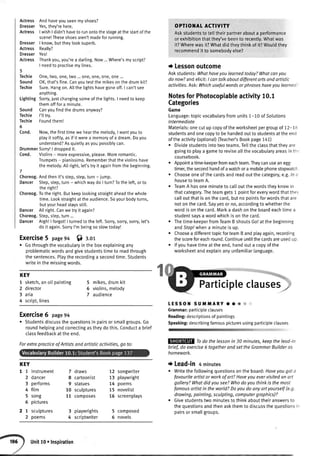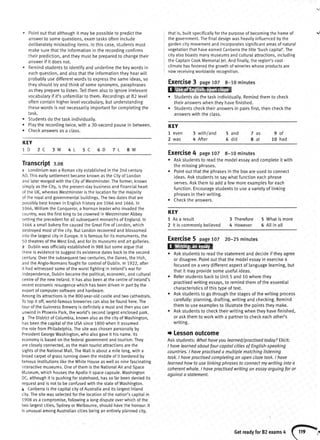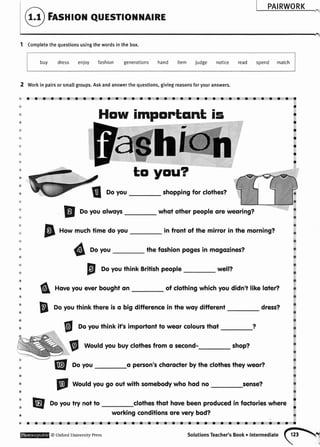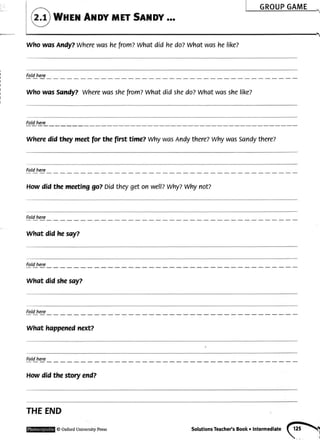This document provides information about the Solutions English language learning course. It includes a summary of the components of the course, including the Student's Book, Workbook, MultiROM, Teacher's Book, Test Bank MultiROM, and accompanying website. It describes the structure of the Student's Book, which contains 10 topic-based units with 7 lessons each, as well as language and skills review sections. It emphasizes that Solutions prepares students for their school-leaving exams by reflecting exam requirements and including exam-specific lessons.

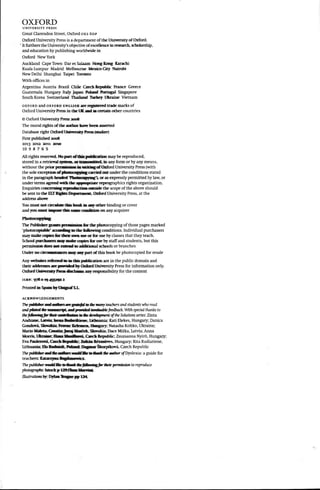
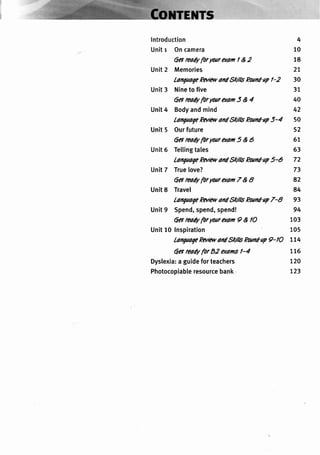
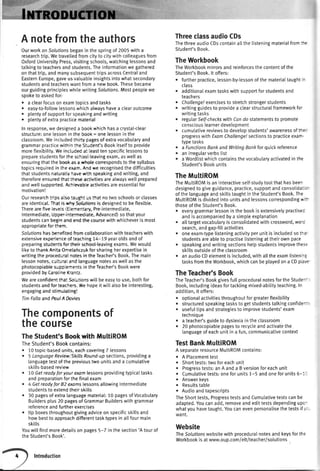









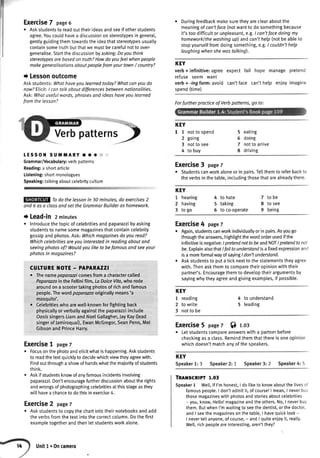










![KEY
: u[e1 past,different
- usedto 3 didn'tuseto
- usedto 4 Did
ixercise 3 page17
'
=ccusontheleornthrslbox.Studentscancomparewitha
rartnerbeforeyoucheckanswers.Attheend,askstudentsto
covertheboxandrecapbyasking:Doweuseusedto totolk
aboutpresenthobitsorsituations?(No)Whichtimeperiod?
past)5ohowdo wetalkaboutpresenthabits?(present
simple,sometimeswithusually)Howdoyouspellusein I
didn'tuseto7Makesurestudentsdon'tadda 'd' (acommon
mistake).
Exercise6 pagetT f) r.rz
r Writeghosttownontheboardandexplainor elicitits
meaning:a townthatusedto bebusyandhavea lotof
peopletivingin it,butis nowempty.
. Pre-teachthefollowingvocabulary:prospectors- peoplewho
searchanareaof [andforgold,oit,etc;foothills- the low
hillsnextto a groupof highmountains;mine- a largeholein
thegroundfromwhichpeopletakecoal,gold,etc.;goldrush
- a periodof intenseexcitementandmigrationcausedbythe
newsthata depositof goldhasbeenfound.
. Tellstudentsthattheyaregoingto listento a description
of a ghosttowncaltedFairview.Theirtaskisto saywhythe
townwasabandoned.Encouragethemto makea fewnotes
astheylisten.Letthemcomparetheirnoteswitha partner
beforecheckingwiththewholeclass.
o Youcouldaska fewmoregeneralcomprehensionquestions,
e.g.:Whereis Foirview?(Colorado,USA)Whenwasit
founded?(1859)
KEY
It becamea ghosttownbecausethegoldrushfinishedaftera
fewyearsandallthepeopleleft.
Thlrscnrpr t.tz
Fairviewis in Cotorado,USA,about300 kilometresfromthe city
of Denver.Therearehousesin Fairview- woodenhouses- and
shopstoo. Butthey'reall empty.Fairviewis a ghosttown- nobody
haslivedherefor morethan a hundredyears.
Fairviewwasfoundedaround1859,whenprospectorsdiscovered
gotdin the foothittsof the RockyMountains.lt grewquickly,as
peoplecamefromall aroundto lookforgold.Soon,it hada
populationof 2,000.Theyworkedin the gotdminesin the hitls
everyday,and in the evenings,theyateand drankin the saloon
in the centreof town.Today,the saloonis empty,likeall the other
buitdings,the minesareclosed,and nobodyworksin the hitls.
Thegold rushfinishedaftera fewyears,andgradually,the people
teft.Today,touristsvisitFairviewbecauseit's a pieceof American
history.Theyanivebycaror coachatongthe newroad.(Because
therewereno carswhenFairviewwasa busytown,therewas no
road.)Theybuydrinksand snackat a coffeebar- the onlynew
buildingin the town- buttheycan'tstayat the hotetbecauseit's
beenctosedfor a hundredyears.Sotheydrinktheircoffeeand
imaginewhatit wasliketo tivein a goldrushtown in the hills.
Exercise7 pagetl f) r.rz
r Focusonthesentences.Playtherecordingagain.Students
comparewitha partnerbeforeyoucheckwiththectass.
KEY
1 doesn'thave
2 don'twork
5 useto
6 did
7 useto
Exercise4 pagetl f) r.rr
. Playtherecordinganddritlthesentenceschoratty.Explain
thatyouaregoingto playthesentencesagainandthistime
youwantthestudentsto listencarefullyto howthe's' and
the'to'arepronounced.Eticittheanswersandthenplaythe
sentencesa thirdtimegettingstudentsto repeatchorally
thenindividually.
KEY the's' is pronounced/s/ thefo is pronounced/tel
PRONUI{CIATIOI{ ]{OTE - USED TO
Explainto studentsthatthe/s/ soundinusedtoiswhat
distinguishesit fromused,thepasttenseoffouse,e.g.I
usedmybikeyesterdoy.lnthetatterthe's' is pronounced/z/.
lt isatsousefulto pointoutthatwithusedto,thefinal'd' in
of usedisnotpronouncedasit isassimilatedintothe't' in
fo.So,I usedto/lveis pronounced/arju:stehv/.
Exercise5 page1z
. Readthroughthetasktogether.Pointoutorelicitthat
studentswitlknowwhentheyneedto writea negative
becauseofthewordony.Checkanswers.
KEY
1 usedto like
2 did(she)useto live
3 didn'tuseto do
4 didn'tusespeak
5 usedto work
6 Did(she)useto be
3 don'teat
4 buy
5 visit
6 can't
7is
I(EY
1 2 Whatdidyourgrandparentsuseto giveyouwhenitwas
yourbirthday?
3 Didthereuseto bea parknearyourhousewhereyoucould
play?
Exercise8 page17
. FocusontheinstructionsandthefirstexamDle.Students
candotheexercisealoneor in nairs.
KEY
1 lt usedto havea poputationof 2,000.
2 Peopleusedto workinthegoldmines.
3 Peooleusedto eatinthesaloon.
4 Peopledidn'tuseto buysnacksinthecoffeeshop.
5 Touristsdidn'tuseto visitthetown.
6 Peopleusedto stayat thehotel.
7 Theredidn'tusedto bea road.
4
5
6
8
22
3
4
Wheredidyourparentsuseto livebeforetheygotmarried?
DidyouusetowatchW onSaturdaymorningswhenyougot
up?
Whodidyourfamilyusetovisitattheweekend?
Didyourmotheruseto readtoyoubeforeyouwentto bed?
Didyouuseto getupearlybeforeyoustartedschoot?
didn'tuseto be
usedto work
usedto play
5 didn'tuseto be
6 didn'tusetowear
7 didn'tusedtodrink
Forfurtherpracticeof usedto,go to:
Unit2.Memories( 25](https://image.slidesharecdn.com/solutionsintermediateteachersbook-150104211909-conversion-gate02/85/Solutions-intermediate-teachers_book-25-320.jpg)

![ADDITIO]IAL SPEAKIT{GACTIVITY
TelIstudentsthattheyaregoingto inventa similarstory
aboutsomeonewhohaslosttheirmemory.Writethe
followingscenarioontheboard:
A 22-year-oldmanwakesup in the emergencydepartment
of a hospital.(Where?)
Hehosa brokennoseand isn'tcorryinga walletor lD,
Hecan'trememberwhohe is.
Hismothertongueis Englishbut hecanspeakanother
languagefluently.(Which?)
Psychiatristsdiscoverhe hasa specioltalent.(What?)
Dividestudentsintopairsorsmallgroups.Theyinventthe
detailsofthestoryanddecidewhathadhappenedto the
manandwhathappenedto himintheend.Attow5-10
minutesforstudentsto plan,makenotesforandrehearse
theirstory.Remindthemto thinkcarefutlyaboutpasttenses.
Studentstelltheirstoriesto theclass.
t Lessonoutcome
{sk students:Whathaveyouleornedtodoy?Whatconyou
1onow?andelicitanswersI canunderstonda magozine
trticleabouto manwholost hismemory.I havelearnedobout
:djectivesand prepositions.
NotesforPhotocopiableactivity2.2
Adjectives+ prepositionsquestionnaire
Pairwork
-anguagearea:adiectives+ prepositions
',/laterials:onecopyof theworksheetperstudent(Teacher's
Sookpage125)
. Handouta copyoftheworksheetto eachstudent.Divide
studentsintopairsandgivethema timelimitof 1-2
minutesto completethesentencesin exercise1 withthe
correctpreposition.
NBSomeoftheadjectives+ prepositionsaretakenfrom2E
andtheVocabularyBuilder,othersarenew.
. Checkanswersandexplainanynewwords.Exptain,using
number8 asanexample,thataftera prepositionweneeda
nounora pronoun.lfwewantto useverb,it mustbeinthe
-ing form,whichisthenounformof theverb.
. Askstudentsto foldbacksection1 andfocuson section2.
Witha weakerclassstudentscanleaveit asit is sothatthev
canreferto theprepositionsin exercise1.
. Studentsworkindividuallyto makequestionsfrom
thestemsgiven.Forthistheyneedto writethecorrect
prepositionandcontinuethequestion.Theyshouldthinkof
questionswhicharepersonallyrelevantto theirpartner.
. Studentsaskandanswerthequestionsin pairs.Circulate
andcheckthattheyareusingtheprepositionscorrectlybut
encouragethemalsoto developtheconversationsbyasking
foltow-upquestions.
KEY
1of
2in
3bv
tEssoll suililARY a.8 tl
FunctionalEnglish:sequencingphrases;showinginterestusing
exctamatorysentences
Listening:dialogues;listeningforspecificinformation
Speaking:narratingevents
Grammar:exclamatorysentenceswilhHowandWhat
Topic:peopte
Todo the lessonin 30 minutes,set the Grammar
Builderashomeworkand keeptheperformancesin exercise8
brief.
+ Lead-in 2minutes
o Withbooksclosed,elicitthe worddate,by asking:Whot
is thewordweuseto talkoboutanorrongementto meet
a newboyfriendor girlfriendor somebodythatyou'd Iike
to becomeyourboyfriend/girlfriend?Thenaskstudents
to imaginewhatcouldgowrongona firstdate.Givethem
differentscenarios,e.g.at a caf6,in a park,in a restaurant,
attheoerson'shouse.
. Askstudentsto ooentheirbooksanddescribewhatthev
canseein theohoto.
Exercise1 pase2o f) r.rr
. Focusontheinstructions,playtherecording,askstudents
to turnto theirpartnersto answerthequestionbefore
checkingin openclass.Witha weakerclasspre-teachfray.
. Witha strongerclass,askstudentsto closetheirbooksand
dotheexercisejustasa listeningtask.
KEY
Martincouldn'tthinkof anythingto say.
Hetrippedandthrewa glassof orangejuiceoverthegirt.
Exercise2 page2o
o Gothroughthesequencingexpressions.Studentsdothe
exerciseindividuatty,byfindingtheanswersin thetext.
. Asyougothroughtheanswers,highlightthefactthatwhen
thesesequencersarewritten,theyarealt(exceptthen)
followedbya comma.
. Again,a strongerclasscoulddothisasa listening
exercise.Ptaytherecordingagainandaskthemto tickthe
expressionstheyhear.
KEY at first intheend
TATfGUAGEXOTE-
'nlAT
THEEflD
Studentsmighthaveheardat theendbefore.Explainthat
at theendis usuallyfollowedbyof,e.g.attheendof the
film, ot theendof the day,at the endof the matchwhereas
withrntheendtheemphasisis onthe factthatsomething
haschanged,e.g.Weweregoing to go to Caf€Zukbut in
theendwestoyedin thepark
Exercise3 page2o
. StudentsreadtheLearnthis!boxindividuatly.Check
understandingoftherulesbywritingupthefottowing
exclamationsandaskif thevarecorrector not.
then
4at
5 about
6 about
7 with
8 about
9 with
10 to
11 with
12 about](https://image.slidesharecdn.com/solutionsintermediateteachersbook-150104211909-conversion-gate02/85/Solutions-intermediate-teachers_book-27-320.jpg)




![g unit3.ilinetofive
TRAxscRrPr1.15
I
Host Welcometo 'What'smyiob?'Andourfirstcontestantis
JakefromManchester.OK,letsstartthequestions!
Me?Oh,oK.HiJake.Doyouusuallyworkoutside?
Yes.
Butyousometimesworkinside.
Yes.
I see.
Doyoubuyorsellanything?
No.
Doyouearna lotofmoney?
No!
Doyouwearspecialctothesforyourwork?
Yes.
A uniform?
Yes.
Hmm.lsyourjobdangerous?
Yes.
Areyoua policeofficer?
No.
Doyouhelpinemergencies?
Yes!
Areyouanambulancedriver?
No.
Doyouvisitpeople'shomes?
Yes.
Inanemergency?
Yes.
Whenthere'sa fire?
Yes!
You'rea [beep].
Yes!
Thankyou,Jake!AndoursecondcontestantisLucy,from
London.Let'sbegin!
Hi,Lucy.
Hello.
Doyoutravela lotforwork?
No.
Doyouworkwithyourhands?
Er...yes.
Doyoumakeanything?
No.
Hmm.Doyouworkoutside?
No.
Doyouworkin anoffice?
No.
Doyouworkina school?
No.
Ina hospital?
Yes.
Aha!
Areyoua doctor?
No.
Areyoua nurse?
No.
Hmm.I don'tknow!Thisisdifficutt.
Doyouwearspecialclothesforyourwork?
Yes.
A uniform?
Er...no.
Butyoualwayswearthesameclothesforwork.
Yes.
Andyouworkina hospital.
Yes.
lsit a hospitatforanimals?
Yes!
Aha!You'rea [beep]
Yes!
Exercise6 page24 f) r.rz
. Givestudentsa fewminutesto completethequestions.
Monitorastheydotheexercise.lf theyseemto beableto
fillin thegapsmoreor lesscorrecttyit maynotbenecessary
to playtherecording.
Man1
lake
Man1
Jake
Man1
Woman
lake
Woman
lake
Woman
lake
Woman
Jake
Woman
fake
Woman
Jake
Man2
Jake
Man2
Jake
Man1
Jake
Man1
Jake
Man1
Jake
Woman
Jake
2
Host
Woman
Lucy
Woman
Lucy
Woman
Lucy
Woman
Lucy
Woman
Lucy
Man1
Lucy
Man1
Lucy
Man1
Lucy
Man1
Man2
Lucy
Man2
Lucy
Man2
Woman
Lucy
Woman
Lucy
Woman
Lucy
Woman
Lucy
Man1
Lucy
Man2
Lucy
KEY
1 outside
2 sell
3 earn
10 office
Exercise7 page24
. Aska studentto cometo thefrontofthe class.Students
takeit in turnsto asktheirquestions.
. Youcouldsetthegameupsothatotherstudentshaveto
guessthejob beforethey'veaskedfifteenquestions.lf they
don'tguessit,thestudentansweringthequestionswinsa
point.Youcouldinstructthestudentto answerthequestion
onlyif it is correctlyformed.Anincorrectlyformedquestion
alsocountsasa oneof thefifteenquestions.Thisshoutd
motivatestudentsto thinkbeforetheyask.
. Studentscontinuethegamein groups.Monitorandcheck
thestudentsareformingcorrectquestionsandusing
vocabularyfromexercise3.
i Lessonoutcome
Askstudents:Whathaveyoulearnedtodoy?Whotconyoudo
nowTElicit:I candescribewhotjobs arelike.I cantolk about
placesof work.I cantalkaboutwhatpeopledo in theirjobs.
Notesfor Photocopiableactivity3.1
fobsCrossword
Pairwork
Language:wordsrelatedto thetopicofiobs(Attlanguageis
takenfrom34 inctudingVocabularyBuilderexercises.)
Materials:onecopyof theworksheetcutin halfperpairof
students(Teacher'sBookpage127)
. Dividetheclassintopairsandhandouttheworksheets.
Tellstudentsnotto showtheirworksheetsto theirpartner.
Explainthattheybothhavethesamecrosswordbutwith
differentwordsfilledin.
r Pre-teachacrossanddoran.Studentstakeit in turnsto ask
eachotherforclues,e.g.Whot's12down?Theirpartner
mustdefinethewordsothatthefirststudentcanfigureout
andwritein theanswer.
. Whenstudentshavecompletedthecrosswordtheylookat
theirpartner'scrosswordto checkspelling.
LESSOIl SUmmARYoooF+
Grammar:definingrelativeclauses
Reading:articlesabouttheworstiobsin history
Speaking:definingwords
Todo thelessonin 30 minutes,keepthelead-in
brief, skipexercise6 andsetthe GrammarBuilderashomework.
i Lead-in 3minutes
o Writethefollowinglistofiobsontheboard:
trafficwarden laundryworker productionIineworker
soldier nanny collcentreworker
4 clothes 7 travel
5 dangerous8 hands
6 homes 9 anything
Definingrelative
clauses](https://image.slidesharecdn.com/solutionsintermediateteachersbook-150104211909-conversion-gate02/85/Solutions-intermediate-teachers_book-32-320.jpg)






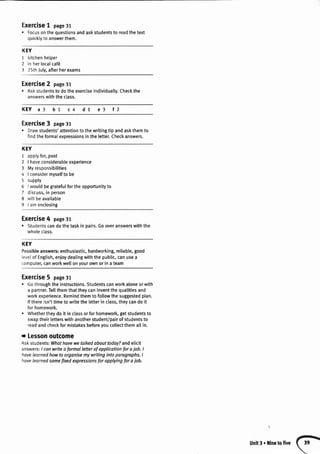


![THIs Uf,IT IxCLUDES O *
Vorabulary.partsofthe body. lnri6uthe body. legaIterms. homophones
. achesand pains. symptoms. illnesses
Grammalo pastsimpleandpresentperfectcontrast.presentperfectcontinuor
Speaklng.talkingaboutdietand lifestyte. at thedoctor's
Wrltlng' an informalletter:givingnews
RKBOO K pages3O-j6 . Setfcheckpage37
vbodThehuman
tEs5()1{ suililARY .. e
Vocabulary:partsofthebody,idiomswithpartsofthebody
Listening:dialogues- listeningforgistandspecificinformation
Speaking:Talkingaboutiniuriesandillness,conversationsand
monologuesillustratingidioms
Topics:people,health
Todo thelessonin 3o minutes,keepthelead-in
brief,setthe VocabularyBuilderexercisesashomework,limit
exercise4 to 3-4 minutesand askstudentstopreporeonlyone
diologueor monologuein exercise7.
t Lead-in 3minutes
o Tellstudentsthatthetopicoftoday'slessonis Thehumon
body.Wifi a weakerclass,givestudents2 minutesto write
downasmanywordsforpartsofthebodyastheycan.Elicit
themontotheboard.Nowtellstudentsthattheyaregoing
to startbydoinga mini-quizto findouthowmuchtheyknow
aboutthehumanbody.Readoutthequestionsandstudents
writedowntheanswers.Theconectanswersareunderlined.
1 Whichpartofthehumanbodyneverstopsgrowing?
a mouth b eyes c nose
2 A babyhasfewerbonesthananadult.Trueorfalse?
(False- a babyhasmorebonesthananadult)
3 Howmuchblooddoestheaveragemanhave?
a 2-3 litres b 5-6 litres c 7-8 litres
4 Whatpercentageofthehumanbodyiswater?
a about50% b about66% c abouIT5o/o
5 Howmanvmusclesarethereinthehumanbodv?
a 650 b 750 c 850
Exercise1 page34
. Studentsworkindividuallyorin pairs.
9 mouth
10 nose
5 chest
6 hairs
fuercise3 page34
o Demonstratetwoorthreeexamplesyoursetforin openpair
acrosstheclassbeforestudentscontinuetheactivitvin
closedpairs.
oPTrol{ALACTTVTTY- StmOI{SAYS
. Playa gameof Simonsoysto revisethe body
vocabulary.
. Explainthatyouaregoingto playa gamet0 practise
thebodyvocabulary.Everybodymuststandup.You
givetheclassinstructionse.g.Simonsays...touch
yourheel,Simonsays...touchyourcalf,Simonsays...
touchyourchinwithyourryrisf.Whenyougivean
instructionprecededbySimonsaysthestudentsmust
followtheinstruction.lfyoudon'tbegintheinstruction
withSimonsays...theyshoulddo nothing.lf a student
doesthewrongactionor doesanyactionwhenyou
don'tsaySimonsoys...,theyareoutofthegameand
mustsitdown.Thelaststudentstandingisthewinner.
Youcoutdaskstudentsto cometo thefrontandgive
instructions.
Exercise4 page34
. Studentsreadnumbers1-6.Askthemto tryto guessthe
meaningoftheinjuryvocabulary.
. Setthetaskandremindstudentsthatthisisa ftuency
activityandyouwantthemto giveasmuchinformation
aspossibte.Toensurethattheylistencarefullyto their
partners,warnthemthattheywilIbeaskedto tellthectass
afterwards abouttheir partner'sexperiences.
. Choosea fewstudentsto feedbackto theclass.
Exercise5 page34
o WriteIDIOMontheboardandelicit/exptainthatanidiomis
anexpressionwitha meaningthatyoucannotguessfromthr
meaningsoftheindividualwords.Forexample:tohittherooi
: to beextremelyangry.Eticitmoreidiomsfromtheclass.
. Witha weakerclass,elicitsomeidiomsinthestudents'owt
language.
. Askstudentsto workwitha partnerto completethetask.
o Emphasiseto studentsthattheyshouldtryto learnidioms
ascompletechunks.Theyshouldrecordthemwitha contex'
sothattheycanusethemappropriately.
KEY
1 1 knee
2 chest
3 toe
4 finger
21teg
2 heels
reg
stomach
back
eye
arm
foot
5
6
7
I
3
4
KEY
a eyelash
b nostril
c eyebrow
d eyelid
e lip
f chin
g scalp
h neck
i throat
i chest
k wrist
I thumb
m stomach
n waist
o hip
p thigh
q catf
r heel
s shin
t ankle
Exercise2 page34f) r.zs
. Playtherecording.Afterthey'velistenedto theanswers
youcouldaskthemto makea roughbut[argersketchof
thepersoninthephotoandaskthemto labelthepartsof
thebody.Drawyourownsketchontheboardanduseit to
checkanswerswiththeclass.
r Eithermodelthepronunciationofjustthepotentially
problematicwords(seepronunciationnote)orreptaythe
recording,stoppingaftereverywordto drittit.
PRO]IUI{CIATION - 5ILEI{T TETTERS
ThislexicalsetcontainsseveraIexamplesofwordswith
silentletters:calf/kc:f/,stomachist,rmak/,thighiOarl,
thumb/0nm/andwrist/rrst/.Writethewordsontheboard
andaskstudentsto tellyouwhichlettersaresitent.
calf stomach thigh thumb wrist
Formorepracticeof Partsof the body,go to:
unit4'Bodvandmind](https://image.slidesharecdn.com/solutionsintermediateteachersbook-150104211909-conversion-gate02/85/Solutions-intermediate-teachers_book-42-320.jpg)
![KEY
cheste
- hairsf
3armb
4 heelsa
5 foot c
6legd
Exercise6 page34 f) r.ze
. Explainto studentsthattheyaregoingto listento
conversationswhichillustratethemeaningsoftheidioms
in exercise5. Playthe recordingandpauseaftereach
conversationto elicittheanswerfromtheclass.
. Witha weakerclassstudentsmayneedto hearthe
recordinga secondtime.
KEY
I Themanistellingthewomanthathe'sheadoverheels.
I Rachel'sputherfootin it.
I Cherytis splittinghairs.
. Rosieis pullingRob'sleg.
; AnthonyistwistingPenny'sarm.
r Sueisgettingsomethingoffherchest.
TRAilSCRIPT 1.26
Jan Jill,I hopeyoudon'tmindwhatI wantto teltyou.
ilt Whatis it, Dan?
Jan I am so in lovewithyou.
itt What?
Dan I'velovedyoufor aslongas I canremember.
],,
Gosh,Dan,I hadno idea.
Rachel Graham,I thinkI'veiustgoneandsaidthe wrongthing.
'lraham Whatareyoutatkingabout,Rachel?
Rachel Rememberyoutold methatyoudidn'ttikeJeff,Amy's
newboyfriend?
Craham Oh no,whathaveyou said?
Qachel Well,it'siustthatAmywasgoingto askyouto meetJeff
for a drink.Youknow,becausehe doesn'tknowmany
Graham
lachel
peoplehere.
And?
Well,I sortof saidthat I didn'tthinkit wasa goodidea.
AndAmysaid,Why?And so l, wett,I triedto explain
- nicelyof course- thatyoudidn'ttikehim.And nowI
thinkshe'sa bit upset.
GrahamOhforheaven'ssake,Rachel.Youandyourbigmouth!
3
4artin Areyoulistening,Cheryl?SoI saidto,imyesterday...
Cheryl lt can'thavebeenyesterday,Martin.
l4artin Whatdoyoumean?
Cheryl ltmusthavebeenthedaybefore.Youdidn'tgoout
yesterday.Oritcouldhavebeenattheweekend,Isuppose.
Martin What?
Cheryl Whenyousawlim.
Martin Look,doesit matter?Doyouwantto hearthestoryornot?
Cheryt Yes,sorry.Dogoon.
Martin AsIwassaying...
4
Rosie Oh,Rob,what'sthaton yourface?
Rob What?
Rosie Thatbiggreenmark.
Rob Whatis it?
Rosie I don'tknow.
Rob Canyou rub it off?
Rosie I'mtrying.No,it won'tcomeoff.Oh dear.Youdo look
funny.
Rob Oh,no.I'tthaveto go home.
Rosie I wasjoking!There'snothingon yourface!
Rob Oh,Rosie!| wishyouwouldn'tdo thatatlthe time!
5
Penny Hi,Anthony.Whatisit?
AnthonyI don'tsupposeyoucouldlendmesomemoney?
Penny No,Icoutdn't.lttookyouagesto payitbackthelasttime.
AnthonyI'msorryaboutthat.I'llpayyoubackstraightawaythis
time,I promise.
Penny No.
AnthonyOh,goon.lt'snotforme.lt'smyMum'sbirthday
tomorrowandIwanttobuyhera present.Please.Please.
Penny Oh,OK,then,hereyouare.That'sallI have.
AnthonyThanks,Penny.That'sreallygoodofyou.
6
Sue Look,Simon,I havetotellyousomething.
Simon Sue,whateveristhematter?
Sue I'vewantedto saythisforages.
Simon Well,goonthen.
Sue Promisemethatyouwon'tbeangrywithme.
Simon lt dependswhatit is!
Sue Erm,please,pleasewillyougeta haircut?| hateyour
hairlikethat.
Simon Oh,wett,if it meansthatmuchtoyou- | supposeso.
Sue Oh,thankyou!| wishI'dtoldyoubefore.
Simon Hmm.
Exercise7 page34
o Tel[studentsthattheyaregoingto writetwoshortdialogues
or monologuessimilarto theonesontherecording.Monitor
andhelpandcorrectasstudentscompletethetask.
. Witha weakerclasshelpstudentsprepareforthetaskby
choosinganidiomandasking,e.g.lf youtwistsomeone's
arm,you wantthemto dosomething.ls it an eosything, or
somethingtheywouldprefernotto do?Brainstormexamples
ofthingsyoumightwantsomeoneto do,andargumentsyou
coulduseto makethemdo it.
Exercise8 page34
. Studentsreadoractouttheirdialoguesandmonologues.
Remindthemto lookupandspeakclearlyandencourage
themto showtheemotionsofthe situation.Theother
studentslistenandguesswhattheidiomis.
Forpracticeofvocabuloryfor lnsidethe body,go to:
KEY
l7
2
3
4
5
skull
skin
ribs
muscle
bone
6 spine
7 brain
8 vein
9 artery
10 heart
11 lungs
12 liver
13 stomach
t Lessonoutcome
Askstudents:Whathaveyoulearnedtodoy?Whatconyoudo
now?andelicit:/ cantalkaboutpartsofthehumanbodyand
injuries.I canunderstandonduseidiomswithpartsof thebody.
Unit4 . Bodyandmind](https://image.slidesharecdn.com/solutionsintermediateteachersbook-150104211909-conversion-gate02/85/Solutions-intermediate-teachers_book-43-320.jpg)








![f tf ctuDEs a &
. computingI nounprefixesacompoundnouns
coltolations. making,acceptingand decliningsuggestions
ro conditionalo speculatingand predicting:will, moy,might, etc.
tEssolt SutttARY.a&
Vocabulary:computing
Listening:a dialogue;tisteningforspecificinformation
Grammar:zeroconditional
Speaking:talkingaboutcomputerusinghabits
Topic:scienceandtechnology
Todo thelessonin 30 minutes,keepthelead-in
briefandsetVocabularyBuilderondGrammarBuilderexercises
for homework.
i Lead-in 3-4minutes
r Writeontheboard:
word e-mails
playing thelnternet
sending processing
surfing gomes
. Askstudentsto matchthecollocationsandaskwhatthe
expressionsallrelateto (Computers).Key:wordprocessing,
playinggames,sendingemails,surfingtheInternet
o Studentsthendiscussthesequestions:Howarecomputers
goodforsociety?ln whotwayscantheybebod?
Exerciset page44
r Studentsreadthetextsanddiscusstheiranswersin
pairs.Tetlthemthattheywittexplorethevocabularyin the
foltowingexercise.
Exercise2 page44
. Studentsdothetaskindividuattyor in pairs.Remindthem
to lookforcluesinthedefinitionsentenceswhichwillhelp
themfindtheanswersin thetext.
ofutufeperfectandfuturecontinuous. will,goingto and
. vurbsfoltowedbyaninfinitive. futuretimeclauses
aboutthe futurer discussingenvironmentalissues. makingpla,
for and against
40-46 . Selfcheckpage4Z
A flashdriveis a smallplasticmemorystickthatstores
information.Youconnectit to a computerwhenyouwant
to usetheinformation.lt performsthesamefunctionthat
a floppydiscusedto perform,butis muchsmallerand
carriesconsiderablymoredata.
Exercise3 page44
. Studentsworkindividuallyor in pairs.Focusfirston
thevocabularyaspectandthenaftergoingthroughthe
answers,explainoreticitthattheseareexamplesofzero
conditionalsentences.
KEY 1d 2e 3a 6b
KEY
1 1 lfyoudon'tusesuncream,yougetburnt.
2 Thebeachesarefullifyougoon holidayinAugust.
3 | understandmyEngtishteacherif shespeaksstowty.
4 lf I don'tputmyclothesaway,mymumgetsangry.
5 lf I eattoomuch,mystomachhurts.
6 lf Matttakeshismedicine,hedoesn'tcough.
Computing
5f4c
2 1 crashes
2 discovers
3 switchesoff
4 use
5 give
6 don'thave
KEY
1 Links
2 Broadband
3 wirelessrouter,getonline
4 webcam
5 laptop
6 blog
7 CD-writer,burn
8 Net
9 videochat
10 download
11 togonto
12 flashdrive
Exercise4 page44 f) r.r+
. Focusonthephotosandaska studentto readoutthe
items.Correctpronunciationif necessary.Readthe
instructionsandplaytherecording.
r Witha weakerclasspre-teachgadget.
KEY c a keyboard,a mouseanda pairof speakers
TRATISCRIPT1.34
IAI{GUAGE ]IOTE - COMPUTTRTERTII{OIOGY
Blogis shortfor weblog.Theactivityof updatinga b/og
iscalledblogginganda personwhokeepsa blogis a
blogger.Blogsaremaintainedusingsoftwarethatcan
beusedbypeoplewithlittleor notechnicalbackground.
Blogsusuatlycontaintext,photos,videos,musicand
linksto otherwebsites.Someblogsare[ikepersonal
diarieswhilstothersprovidenewsandcommentaryona
particularsubjecte.g.news,sport,politicalissues.
Broadbandis a typeof connectionto theInternetthat
allowsyouto receiveor senda lotof information,
includingpictures,musicandvideo,veryquickly.
A wirelessrouterisa machinewhichsendsinformationto
theappropriatepartof a computernetwork.lt allowsyou
to receivean lnternetconnectionwithoutneedinga cable.
Assistant
Customer
Assistant
Customer
Assistant
Customer
Assistant
Customer
Assistant
Customer
Assistant
Customer
Assistant
Customer
Goodmorning,Sir.CanI hetpyou?
Ah,yes.I needto buysomethingfor myson.lt's his
birthdayat the weekend.
OK.Sowhatexactlyareyou lookingfor?
Wett,I'm notsure,really.ButI knowhe likescomputerr
and gadgets,andthingstikethat.
Hashe atreadygota computer?
Yes,he has.Buthe'salwayscomplainingaboutit! He
says'it'stikeyou,dad - too otd,and too stow'.
Well,maybehe'd likea newlaptop.
Yes,maybe.Howmuchis this one?
Actuatly,that'sa printer.Futlcolour.lt canhold 50
sheetsof paper.lt's onlyf35 - or freewith anynewL(
monitor.
Oh,I see.I don'twanta printer.I thinkhe'sgotone.
Whatdoeshe usehis comouterfor?
Mosttyfor computergames,I think.
Wett,this is a goodone- and lessthanf 500.lt's got
512 megabfesof RAM.
What'sRAM?
Forfurtherpracticeof Zeroconditionalgo to:
52 ) Unit5.Ourfuture
,/](https://image.slidesharecdn.com/solutionsintermediateteachersbook-150104211909-conversion-gate02/85/Solutions-intermediate-teachers_book-52-320.jpg)








![cPlc a & ,'
rfI
.t:a:lTWi%&;l;.,{l;r-;'1,:,ta:t :,::,.::... :.
* Lead-in2minutes
NriteAncientEgyptI'etnlanL,r:d5rpt/ontheboard.Ask
uvhereEgyptis situated(thenorth-eastofAfrica),whatthe
rapitalcityiscalled(Cairo),whatitsmainriveris(theNile),
,rndwhattimesin historyarereferredto asancient(BC-
ireforethebeginningoftheChristiancalendar,traditionally
caLculatedfromthebirthofJesusChrist).
i iicitanyideasthatstudentsassociatewithEgypt(e.g.
ryramids,pharaohs,mummies,theSphinx,hieroglyphics).
ellstudentstheyaregoingt0 readaboutthehistoryof
,'cortinAncientEgypt.
,{erCise1 page52 3minutes
;ocusstudentsonthesports.Ask:Doyouknowthehistory
tf anyof thesesports?
'rVorkingin pairs,studentsunderlinethesportsthey
,issociatewithAncientEgypt.Elicitanswers.Encourage
,tudentsto tryandjustifytheiranswers.
iY
n the[ist,onlycricket,curlingandrugbywerenotknownin
ientEgypt.
,(erCiSe2 page52 3 minutes
Ixplainthatscanningis readingquicktyto findspecific
in[ormation.Pointoutthatwhenyouscan,youonlyfocuson
rheinformationyouneed.
Studentsreadthetextquicklyto seewhichsportsare
nrentioned.Remindthemthatsomeofthewordsmay
appearinthemissingsentencesA-G.
Checl<theanswersin class.
.EY wrestling,boxing,yoga,swimming,horseriding
-xerCise3 page52 15minutes
j.."'/W
Readtheinstructionstogetherwiththeclass.
Explainthatin thistypeoftasktheyshouldfirstreadthe
r,vholetextcarefully,andtryandidentifythemainideaof
eachparagraph.Thentheyshouldreadthesentencesbefore
andaftereachgapto seewhatinformationis missing.
Thekeyto completingthetaskisto findthelinkingwords
andrelativepronounsthatlogicatlyconnectthetextto the
missingsentence.
ReadsentenceA together.Elicitthemeaningof therefore.
lxplainthatthereforeexpressesa conctusion,whichmeans
theprevioussentenceshouldofferanargumentto support
thestatement.
Studentscompletetheexerciseindividuatly.
Checktheanswersin ctass.Askstudentsto readthoseparts
ofthetextthatreferto informationinthemissingsentence.
:.',:,:'.;'
]
rt
Exercise4 page5210-12minutes
. Writetheseheadingsontheboard:
verb noun adiective adverb
o
o
a
Focusstudents'attentiononthewordsin brackets.Ask
studentsto saywhatpartof speechtheyare.Writeeach
wordunderthecorrectheading.
Studentsshouldfitlinthemissingformsinthetabte.Ina
weakerclass,do thistogetherin class.Ina strongerclass,
studentscancompletethetableindividuatly.Remindthem
thatsomewordsmayhavemorethanoneformfora column
(forexample,a nounforanactivityorfora persondoing
thatactivitylikegardeningandgardener).
Explainthatin a wordformationtask,it isa goodideato
readthewholetextfirst,andusecluesfromthetextto
decidewhatpartof speechis missing.
Studentscompletethetaskindividuatty.
Theycomparetheiranswersin pairs.
Checktheanswersin class.
KEY
1 strength
2 concentration
3 differences
4 competitors
8 player
9 steadily
10 named
Exercise5 page52 5minutes
. Readthestatementtogether.
. Studentsworkin pairsto collectargumentsforandagainst
thestatement.
. Conducta briefclassfeedback.
Exercise6 pagesz 5minutes
W
. Referstudentsto theFunctionsBankintheWorkbook
forusefulphrasesforpresentinganargument,agreeing/
disagreeing,etc.
o Askstudentsif theyagreeor disagreewiththestatement.
Pairupstudentssotheyworkwithsomeonewhorepresents
theotherpointofview.(lftheclassis unevenlysplit,ask
somestrongerstudentsto switchsidesin thediscussion.)
. Studentsdiscussthestatementin pairs.Walkaroundand
monitortheactivity,focusingespeciallyonthefunctional
pnra5e5.
t Lessonoutcome
Askstudents:Whathaveyoulearned/practisedtoday?Elicit:I
havepractisedcompletinga textwithmissingsentences.I have
practisedwordformationgapfill. I havelearnedhowto present
myopinionon o stotement.
5 longer
6 winning
7 decision
3CZLIEY 1 D 4A 5G 6B
GetreadyforyourExam5
(}](https://image.slidesharecdn.com/solutionsintermediateteachersbook-150104211909-conversion-gate02/85/Solutions-intermediate-teachers_book-61-320.jpg)

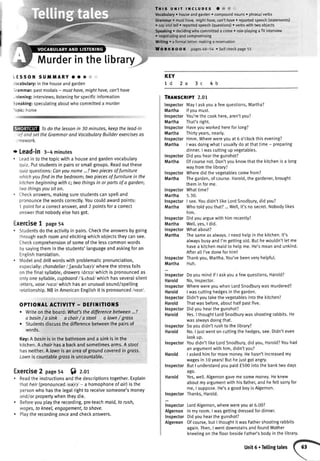



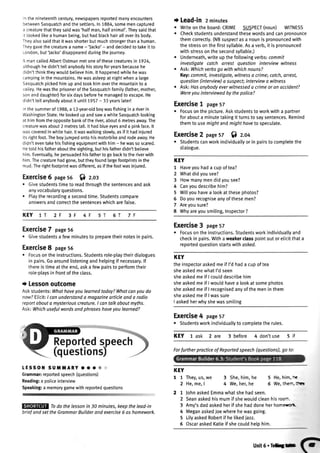




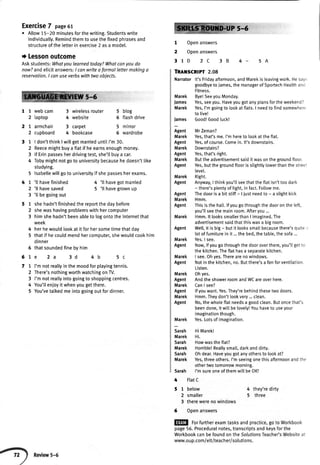



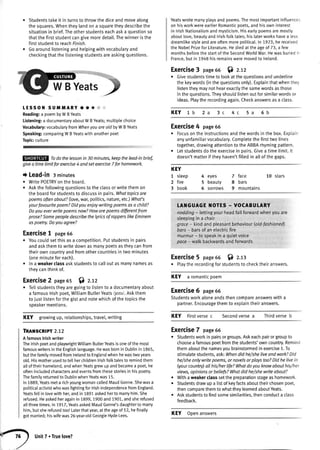
![r Lessonoutcome
-sl<
students:Whathaveyoulearnedtoday?Whatcanyoudo
.ow?andtryto elicit:I havelearnedaboutthelifeof WB Yeats.
canunderstanda poem.I cantalkaboutthelifeof a famous
,oef.Ask:Whotusefulwordsor phraseshaveyoulearnedT
KEY
1 wentout,wouldn'ttalk
2 wouldn'tchatup,didn'tfancy
3 didn'tlike,wouldstop
4 wouldn'tgoout,asked
5 wouldtry,knew
6 splitup,wouldbe
7 wouldbe,gotengaged
I got,wouldgo
LESSON SUililARY o to &.;:
Grammar:secondconditional,I wish,lf only,I'd rather,
Listening:dialogue;listeningforgist
Speaking:talkingaboutimaginarysituations
Todo the lessonin 30 minutes,keepthe lead-in
sriefandsetthe GrammorBuilderexercisesfor homework.
r Lead-in 2 minutes
. Writeontheboard:lf youhave/had€3,000andyouhave/had
tospendit today,howwould/willyouspendit?
. Eticitthecorrectalternativesandgivestudentsa minuteto
answerthequestionin pairs.Thenasksomestudentsto tell
youwhattheywoulddo.Makesuretheyusethecontracted
formI'd.
Exercise7 page67 f) z.r+
. Focusonthephotoandaskwhotheycansee,whattheyare
doingandwhattherelationshipis betweenthem.Focuson
theinstructionsandplaytherecordingonce.
. Witha weakerclassgivestudentstimeto readthedialogue
throughbeforetheylisten.
Exercise4 page67
e ReadtheLearnthis!boxasa classor askstudentsto read
it silenttyontheirown.Afterpoints1 and4 ask:Doesthis
meonnowor in thepasf?(Althoughtheanswerisnow,
studentsmightthinkit'sthepastbecauseofthepasttense.)
KEY
1 lwishwecouldafford...; if ontywehad€3,000...
2 | wishyou'dbemoreromantic...
3 I'drathergoskiing...
4 WouldvouratherI wore...?
Exercise5 page67
r Studentscanworkindividuattyor in pairs.Checkanswers
withtheclass.
Talkilgabout
imaginarysituation
KEY
1 | wish/ lf only
2 I'drather
3 lwish / lf onty
4 I'drather
5 I'drather
6 | wish/lf only
KEY
1 coutd 4 we'dspend
2 had 5 wouldn'tbe
3 was 6 were
They'refaltingout (b).
TAXGUAGE]{OTE. I WISH,IF ONLY,I'D RATHER
1wishandlf onlyaremoreor lesssynonymousbutlf onlyis
lesscommonandexpressesa deepersenseof longingfor
somethingwhichisa remotepossibitityandwouldchange
everything,forexample,lf onlyhe waswithme .... However,
lf onlyyoudidn'ttapyourpen likethatsoundsa littleover
thetop.I wish,ontheotherhand,is a simplestatementof
desire,e.g.Iwish hewouldcollmoreoften.
Both/ wlshandif onlycanbe usedto expressideasthat
areveryfarfromthe presentsituation,whereasl'd rather
is usedmoreforpossiblechoices,e.g.I'd rathertheycame
at sixo'clocknotseveno'clock.
Exercise6 page67
. Elicittwoorthreeexamplesentencesandwritethemonthe
board.Studentscontinueindividuatlvor in pairs.
Exercise2 page67
. ReadtheLeornfhislboxtogether.Studentsdo the exercise
alone.Checkanswerstogether.
. Hightightthefactthattherfclausecangofirstor second.lf
it isthefirstpartof the sentence,a commais needed.lf it is
thesecondpart,nocommais needed.E.9,.lf I wasrich,we'd
...but /f wouldn'tbe boringif you....
KEY
pastsimple,would
Therearethreeexamples.
Exercise3 page67
. Studentscompletethetaskaloneor in pairs.
. Youcouldgothroughthe answersbyaskinga studentto
forma questionfromnumberone:Whatwouldyoudo if you
hod€3,000fora holiday?andthennominatinga student
to answer.Thesecondstudentasksthenextquestionand
nominatesa thirdpersonto answer.etc.
7 you'dbe
8 didn't
9 we'dhave
10 wore
KEY
Possibleanswers
I wish...she'ddo betterin herexams/ shehada iob/ | didn't
haveto work/ welivedin theUSA/ ourparentswouldn'tworry.
lf only...she'ddo betterin herexams/ shehada job / | didn':
haveto work/ we tivedin theUSA/ ourparentswouldn'twor,-
I'd rather...shehada job / stayin bed/ welivedin theUSA.
lf sheworkedharder...she'ddo betterin herexams/ our
parentswouldn'tworry.
She'dhavemoremoneyif ...shehada iob/ we livedin tl'e
USA.
Formoreprocticeof theSecondconditionol,go to:
unitT.Trueld](https://image.slidesharecdn.com/solutionsintermediateteachersbook-150104211909-conversion-gate02/85/Solutions-intermediate-teachers_book-77-320.jpg)
![Formorepracticeof I wish,lf onty,I'd ralher,go to:
KEY
2 | tived
3 couldfind
4 youdidn't
5 youwould
5 hewasn't
7 youdidn't
8 youwouldn't
9 wehaddinner
Exercise7 page67
o Focusontheinstructionsandtheexamole.Doanotherone
ortwowiththewholeclass.Thenstudentscontinuethetask
in oairs.
I Lessonoutcome
Askstudents:Whatdidyoulearntoday?Whatconyoudonow?
andeticitanswers:I cantalkaboutimaginarysituations.I
understandhowto usesecondconditionalsandI wish,lf onlyond
l'd rather.Ask:Whotusefulwordondphraseshaveyoulearned?
Exercise2 page68
Focusonthereadingtipandelicitideasaboutwhatkindof
informationeachtypeoftextmightcontain.Thenaskstudent:
to lookveryquicktyatthetextandsaywhichtypeit is.
Askwhatcluesledthemto theiranswer(thetitte,theweb
pageformat,theinformalstyle).
KEY b
Exercise3 page68
e Askstudentsto readthetextandhightighttheadvantages
anddisadvantages.Don'tansweranyquestionsabout
vocabularyatthisstage.Instead,remindthemthattheyca
do manyexerciseswithoutunderstandingeverything.
KEY
Theauthorthinkstherearemoreadvantagesthandisadvantage'
Exercise4 page68
. Studentsworkindividuallythencomparewitha partner,
iustifyingtheiranswers.
KEY
1 False.Theyarewoniedthatshespendstoomuchtimeonline
2 True. 3 False.Theydon'tfatloutwithherif sheis late.
4 True 5 False.Shehasa job. 6 True 7 False.She
feelssheknowsherInternetfriendsandtheyaredearto her.
8 True
Exercise5 page58
o Askstudentsto lookat thewordsin contextin orderto
guessthemeaning.Checkanswerstogether.
KEY
1 closeto yourheart
2 anobligation
3 runningin circles
4 futfitling
5 nothingin common
6 interrupt
7 iudge
Exercise6 page59
o Studentsthinkabouttheiropinionsaloneandthencompar
ideasin pairsor smallgroups.
CUTTUREI{OTE-
'IEROThesongHerowasreleasedbyEnriquelglesiasin 2001.lt
reachednumberonein 10 countries.
Exercise7 page69
. Tellstudentstheyaregoingto listento a songcalledHero
Youcouldaskthemto lookquicktyatthelyricsofthesong
andsaywhatsortof songit ts.
. Theyworkinpairstocompletethelyrics,rememberingtochang
someoftheverbsintothepast.Dothefirstlinetogether.Withr
weakerclass,pre-teachsweor,soulandtremble.
. Asthereis morethanoneplausibleanswerforsomeof the
gaps,tetlstudentsto writein pencilatthisstage.
KEY
I dance
2 asked
3 run
4 saw
5 save
6 touched 11 hide
7 taugh 72 care
8 love 13 hold
9 stand 14 hotd
10 be 15 care
"""b***^
Internetrelationships&
tEssolt SUMMARY .. w
Reading:anonlinearticle;true/falsequestions
Listening:asong- Hero
Speaking:discussingInternetfriendships
Topics:peopte,relationships
Todo thelessonin 30 minutes,keepthelead-in
brief,askstudentsto readthetextat homebeforethe class,
anddo exercise3 togetherasa class.
r Lead-in4minutes
. Putthefollowingwordsontheboardandaskthestudents
whichareconnectedwithInternetrelationships.
sociolnetworkingsite chatroom meetinghacking
colleaguepublicrelationse-pal forums MySpace
Facebookpersonalprofile
Key:socialnetvvorkingsite,chotroom,e-pal,MySpace,
Focebook,personaI profile
Ask:Doyouchatwithyourfriendson thelnternet?Haveyou
madeonynewfriendson thelnternet?Doyouknowanyone
whohasTDoyouhavea pageon a socialnetworkingsite?
Wouldyouliketo?
CULTUREI{OTE. SOCIAIIIETWORKI]IGSITES
Socialnetworkingsitesareplacesonthe Internetwhere
peoplemeetin cyberspaceto chat,socialise,debateand
meetnewfriends.A memberhastheirownwebsite,on
whichtheyputa personalprofile,writeblogsandcan
posfphotos,music,videosforotherpeopleto lookat,
Socialnetworkingis immenselypopularwithteenagers
andyoungadults,muchmoresothanonlinechatting.
Themostpopularinternationalsocialnetworkingsitesare
Myspoce,Friendster,andFacebook.
Exercise1 page68
e Focusonthephotoandaskwhatis happening.
. Askthestudentsto discussthequestionsin pairsandsmall
groupsandthenopenupthediscussionto thewholeclass.
UnitT.Truetove?](https://image.slidesharecdn.com/solutionsintermediateteachersbook-150104211909-conversion-gate02/85/Solutions-intermediate-teachers_book-78-320.jpg)
![lxercise8 page6e f] z.rs
. Playtherecordingsothatstudentscanchecktheiranswers.
Pauseaftereachverse.
. Askstudentswhattheythoughtofthesong.
Exercise9 page69
. Focusontheinstructionsandaskstudentsto discussthe
answerin pairs,explainingwhytheotheroptionsarewrong.
KEY d
Exercise10 pase69
. Givestudentstwominutesto brainstormsongsin pairs.
Askstudentsto readouttheirsongs.Encouragediscussion
ifthereisanydisputeaboutthemeaningofthesongs.Ask
whichsongtheythinkisthebest,thesaddest,etc.
r Lessonoutcome
;k students:Whathaveyoulearnedtoday?Whatcanyoudo
tw? andelicitanswers:I canunderstandanarticleabout
'ternetrelationships.I conunderstandthesongHero.Ask:
'.hotusefulwordsandphraseshaveyoulearned?
LESSOil SUMTARY o. o 4
'unctionalEnglish:initiating,sustainingandendinga conversation
-istening:dialogues;listeningforgistandspecificwords
Grammar:questiontags
5peaking:a socialconversation
Topic:freetime
Todo the lessonin 30 minutes,setthe Grammar
,:uilderexercisesfor homework,keepthe timefor the
'reporotionphasesin exercises7 and 8 brief,ond limit the
'umberofperformancesin exercise9.
+ Lead-in 2minutes
. Writeonthe board:Makingconversation
. Dictateorwriteupthefollowing5 sentences:.I feelperfectly
confidentoboutstartingconversationswithpeopleI don't
know.l'm shyaboutstortingconversationswith newpeople
but if theystarttheconversotion,l'm happyto chat.I hate
hovingconversationswithpeopleI don't know.Makingsmall
tolkis embarrassingondannoying.
. Askstudentsto workin pairsorsmallgroupsandsaywhich
descriptionfitsthembest.Encouragethemto giveexamples.
. Explainthatin thislessontheyaregoingto belookingat
differentwaysof makingconversationin Engtish.
Exercise1 page7o f) z.ro
. Referstudentsto thephotoandtheinstructions.Ptaythe
recordingandelicitanswers.
. Witha strongerclassaskstudentsto coverthedialogue.
. Youcouldaskstudentsto guessthemeaningofAreyou
reollyintosportT,l'd better...,Seeyouaround,elicitinga
translationforeachexDression.
KEY
1 ConnorplaysvolleyballwithTanya'sbrother.
2 Theybothtikefitms.
3 Hehasto gobackto hisfriends.
Exercise2 pageTo
. Readthroughtheinformationin theLearnthis!boxtogether
andaskstudentsto findtwoexamplesof questiontagsin
exercise1.
KEY
You'reBenWilson'ssister,aren'tyou?
Therearesomegoodfilmsonat thecinemanowaren'tthere?
KEY
I 1 aren'tyou?
2 haven'tthey?
3 didn'the?
4 wouldyou?
5 doesn'the?
6 don'tyou?
7 wiltyou?
8 canhe?
Exercise3 pagezo
r Studentsworkindividuallyor in pairscheckasa class.
. Modelanddrilttheoronunciation.
KEY
1 I'vemetyourfriendbefore,haven'tl?
2 Youcameto myparty,didn'tyou?
3 You'rethegirtwhoworksin thesupermarket,aren'tyou?
4 Youusedto beat myschool,didn'tyou?
5 Youwereattheconcertlastweekendweren'tvou?
Exercise4pageTo$z.tt
. Focusontheinstructionsandptaytherecordingonce.Ask
thestudentsto recallasmuchofthe conversationsasthev
canwitha oartner.Elicittheanswer.
KEY 1 BenandSue
Thlrscnrprz.tz
7
Sue Here'syourcoffee.
Ben Thanks.We'vemetsomewherebefore,haven'twe?
Sue I'mnotsure...er...inthiscaf6?
Ben No,thisisthefirsttimeI'vebeenin here!Oh,I know.Doyou
goto a dancectassonSaturdays?
Sue Yes,I do!Howdoyouknow?
Ben BecauseIgoto a martialartsclassatthesameplace.You're
alwaysleavingasI arrive.
Sue Yes!Nowthatyoumentionit,yourfaceisfamitiar.What's
yourname?
Ben.
I'mSue.Niceto meetyou.
Andyou.
So...Whatelsedoyoulikedoingatweekends.
I'mreallyintorunningatthemoment.
Really?Soaml!
Hey,doyouwantto gofora runwithmeonedaysoon?
I'dloveto.Whydon'tI giveyoumymobitenumber?Youcan
calIme.I'llwriteit downforvou.
Ben Great!I'ttcallyousoon.
Sue I hopeso.Anyway,it'stimeIgotbacktowork,
Ben
5ue
Ben
Sue
Ben
5ue
Ben
5ue
2
Ed
Forfurtherpracticeof Questiontogs,go to:
Making
conversation
Hi,I'mEd.
UnitT.Truelove?](https://image.slidesharecdn.com/solutionsintermediateteachersbook-150104211909-conversion-gate02/85/Solutions-intermediate-teachers_book-79-320.jpg)

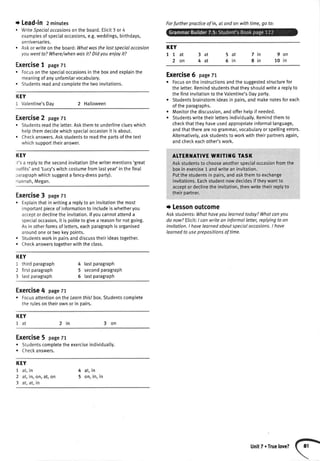



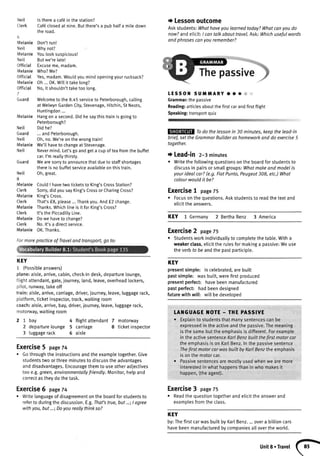










![Formorepracticeof Reflexivepronouns,go to:
CUTTURE]IOTE . ASHLEE SITIPSOT{
Bomin 1984,AshleeSimpson,isa singer-songwriterand
actress.Shebecamefamousin2004withhernumber-one
albumAutobiogrophy.She'starred'inatelevisionrealityshow
TheAshleeSimosonShowaboutherownlifeonMW.The
showappearedintheW slotstraightafterhersistefsshow.
.lessicaSimpsonwasbornin 1980androseto fameinthe
late1990swithheralbumSweetKrsses.Shethenbecame
a householdnameasa resultof hertelevisionrealitv
show:Newlyweds:NickandJessica.
Exercise3 page85
KEY
1 2 No,shedyesit herself.
3 No,theycleanthemthemselves.
4 No,heshavesit himsetf.
5 No,I paintthemmyself.
6 No,werepairthemourselves.
7 No.wecookthemoursetves.
2 t hurthimsetf
2 burnthemselves
3 lookafterourselves
4 cutmyself
5 getherself
6 turnitself
KEY
Shehadherhairdyedblonde.
...havingherfacechangedtoo
shehadhernosealtered
shehadherteethwhitened
she'shadherchinreducedtoo
ReadthroughtheLeornthisJboxtogetherandcheck
comprehensionbyaskingconceptquestionssuchas:Did/
cutmyhair?(No)DidI arrangeforsomeoneto cutit? Ues)
DidI arrangefor mycarto bestolen?(No).
Askstudentsto underlineexamolesofthestructureinthetext.
Exercise6 pases5
. Focusontheinstructionsandtheexample.Doonemore
sentenceontheboardasanexampte.Studentswork
throughthesentencesindividualtyor in pairs.
KEY
1 Shehadhermake-uodone.Shedidn'tdo it herself.
2 Shehadhertattooremoved.Shedidn'tremoveit hersetf.
3 Wehadourcarrepaired.Wedidn'trepairit ourselves.
4 Hehadhisteethexamined.Hedidn'texaminethemhimsel;
5 | hadmyeyestested.I didn'ttestthemmyself.
6 Theyhadtheircarcleaned.Theydidn'tcleanit themselves
7 Youhadyourhousedecorated.Youdidn'tdecorateit
yourself.
8 Youhadyourbackswashed.Youdidn'twashthem
vourselveS.
Exercise7 page85
Readtheinstructionsandtheexampledialogue.Students
askandanswerthequestionsin pairs.Encouragethemto
askfoltow-upquestionsiftheanswerisyesandbeprepare,
to reDorttheinformationbackto theclass.
Witha weakerclassaskstudentsto writeouttheir
questionsin futtbeforetheyasktheirpartner.
o Askstudentsto reportto thectassanythinginteresting
they'vefoundoutabouttheirpartner.
t Lessonoutcome
Askstudents:Whatdidyoulearntodoy?Whatcanyoudo
now?andelicit:/ cantalkaboutthingsthotI havearranged
forsomebodyto do.I cantolkaboutunpleasantthingsthat
havehappenedto me.I canusereflexivepronouns.Ask:Whicl'
usefulwordsandphrasesconyouremember?
Exercise4 page85
. Studentsworkindividuatlyandthencompareanswerswith
a Dartnerbeforeclassfeedback.
. Askstudentswhynumber6 isdifferent.(lt'ssomething
unpleasantthathappenedto herthatwasn'tarranged.)
KEY
t hadmyhaircut
2 Didyouhaveit dyed
3 hadmynailspainted
4 hadmymakeupdone
5 hadmyteethwhitened
6 hadmybagstolen
KEY
1 2 | havehadmyhairdyed.
3 Theyhadtheirhousepaintedlastyear.
4 Tomis havinghiscarrepaired.
5 Myneighboursarehavingtheirwindowschanged.
5 | amgoingto havemyphotographtaken.
7 Oliviahadhereyestestedlastweek.
8 Harveyhashadhiscoatdry-cleaned.
9 Wearegoingto havea newshowerinstatled.
2 1 Hasshehadherhaircut?
2 she'shadit dyed
3 Shehasn'thadhernosereduced
4 Hasshehadherteethwhitened?
5 Hasshehadit made
5 shehadhermake-updone
Exercise5 page85
o ReferstudentstotheLearnthislbox.Askdifferentstudents
to readoutthetwosections.Studentsfindanexampteofa
reflexivepronounin4 anddecidewhetherit isuse1 or2.Elicit
theotherreflexiveDronounsandwritethemontheboard.
KEY
I didthatmyselfat home.(Use2)
mysetf,yourself,himself,herself,itself,ourselves,yourselves,
themselves
Advertisinginschools
IESSOl{ SUMTARY a a *',,,,,
Reading:an articleaboutadvertisingin schools;questions
Listening:peopletatkingadvertisingin schools
Vocabulary:smalland [argenumbers
Speaking:discussingadvertisingin schoots
Topic:shoppingandservices
Todo thelessonin 3Ominutes,keepthelead'in
brief,askstudentsto readthetextbeforethelessonondsettht
VocobularvBuilderexercisesfor homework.
Formoreprocticeof havesomethingdone,go to:
unitg.spend,spend,spend!](https://image.slidesharecdn.com/solutionsintermediateteachersbook-150104211909-conversion-gate02/85/Solutions-intermediate-teachers_book-96-320.jpg)
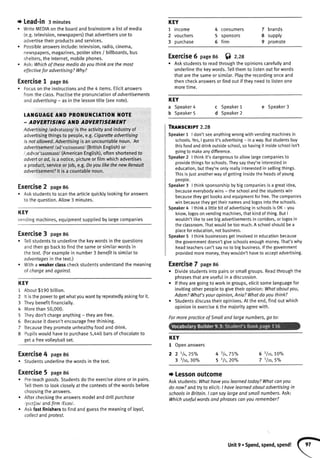
![Thirdconditionary
tEssoll suMtARY .. e
Grammar:thirdconditionaI
Listening:a dialogue
Speaking:talkingaboutimaginarysituations
Pronunciation:sentencestressin thirdconditionalsentences
Todo thelessonin 30 minutes,keeptheleod-
in brief,do exercises2 and4 togetherandsettheGrammar
Builderexercisesfor homework.
t Lead-in 3-4minutes
Putthefotlowingquestionsontheboardforstudentsto ask
andanswerin oairs:
Whenyougo on holiday:Doyoudoyourpackingwell
in advanceor doyouleaveit to thelastminute?Doyou
usually/ sometimes/ neverleavesomethingimportant
behind?Giveon example.Haveyouevermissedan
importanttrain,planeor otherappointmentbecouseyougot
thetime wrong?
Conducta briefctassfeedback.
Exercise1 page87 f) z.zs
Tellstudentsthattheyaregoingto readandlistento a
dialoguebetweentwopeoplewhohavelustarrivedattheir
holidaydestination.Focusonthephotoandask:Whereore
thepeople?(Manhattan/ NewYork)
Studentslistenandcompletethedialogue.
Exercise4 page87 f) z.ro
Studentsdotheexerciseindividuallyor in pairs.Remind
themto usecontractions(shortforms).ThegeneraIruteis
thatcontractionsareusedafteroronounsbutnotnouns
(NBthefullformis usedin 8 to addemphasis).Ptaythe
recordingforthemto checkanswers.
Asyoucheckthefirstfewanswersaskconceptquestions,
e.g.Didshebecomea singeror an actress?Isthisin the
past,presentorfuture?
KEY
t hadn'tbecome
2 'd havepaid
3 'd havewon
4 hadbeen
5 wouldn'thavefailed;she'dworked
6 wouldn'thaveeaten;'d seen
7 wouldn'thaveleft:hadn'tbeen
8 wouldhavebeen;hadn'tspent
KEY
1 would
2 wouldn't
3 hadn't
4 known
5 hadn't
Exercise2 pase87
. Studentsdotheexercisealoneor in pairs.Checkanswers.
KEY
1 No 2 Tyler 3 No 4 BecausehewantedAmytobringit
Exercise3 page8z
. Readthroughtheinformationin theLearnthis!boxtogether,
stoppingaftereachpoint.
Tohighlightthedifferencebetweenthesecondand
thirdconditional,trydictatingtwoiumbledsentences,
askingstudentsto putthemtogetherandtheneticitthe
difference(the3rdconditionalformrefersto theimaginary
past,whereasthe2ndconditionalrefersto theimaginary
present).Forexample:
lf/boughtfl/ enough/ had/ money/,/ hod/./ have/I/ it/wouId
(lfI hadhadenoughmoney,I woutdhaveboughtit.)
enoughlf/ buyl / money/,/wouId/ it/.I / had
(lfI hadenoughmoney,Iwouldbuyit.)
Pointoutthatiftheifclauseisattheendofthesentence,
nocommaisneeded.
Askstudentsto readoutthedialoguein exercise1 to give
themmechanicalpracticein 'gettingtheirmouthsaround
thestructure'withouttheextrastressof havingto formulate
thesentencesthemselves.
KEY Therearefourexamples
Exercise5 page87 f) z.ro
. Playthefirsttwosentencesandaskstudentsto lustlisten
to howhaveispronounced.Eticitthatit is pronounced/or
andthenptaytherecordingforstudentsto repeatchorally
andindividuatty.lt is importantnotto omitthechoralstage
otherwisestudentswon'tgetsufficientpractice.
IA]IGUAGE TIOTE. PROTIUI{CIATIOTIOT HAVE
Althoughhoveis pronounced/evlit shouldbewrittenin its
fullformandnotasa contraction.
Exercise6 pagesl
o Focusontheinstructionsandtheexample.Studentswork
individuallyorin pairs.Tellthemthattheycanputthetf
clauseatthebeginningorendofthesentence.Remind
themto useshortforms.Checkanswersasa class.
KEY
1 Wecouldhavepaidfordinnerifyou'dbroughtyourcreditca'
2 We'dhavegoneskiingif it hadsnowed.
3 I'dhaveinvitedyouto mypartyif I'dhadyournumber.
4 She'dhaveboughtyoua presentif she'dknownit wasyou
birthday.
5 I'dhavemadepizzaif I'dhadsomeflour.
6 lf it hadbeensunny,they'dhavegoneto thebeach.
Exercise7 pagelT
. Focusoftheinstructionsandtheexamples.Dothefirst
exampletogether,thenstudentscontinuein pairs.
r Alternatively,youcouldgetstudentsto askeachother
thequestionsacrosstheclassbeforestudentsrepeatthe
exercisein pairs.
Formorepracticeof Thirdconditional,go to:
KEY
t 2 lf Hotlyhadn'tforgottenhercreditcard,shewouldhave
boughta newW.
3 Wewouldn'thaveboughta newcarifwehadn'taskedf,
a bankloan.
4 lfAmyhadn'tgoneto thesales,shewouldn'thavefoun,
a bargain.
5 Samuelwouldn'thaveborrowedthemoneyforthe
presentif hehadsavedup.
6 lf Daisyhadn'thadenoughmoney,shewouldn'thave
tentBeniaminf 50.
7 Josephwouldhavefounda cheapleatheriacketif heh.r
lookedin thesales.
unitg.spend,spend,spend!](https://image.slidesharecdn.com/solutionsintermediateteachersbook-150104211909-conversion-gate02/85/Solutions-intermediate-teachers_book-98-320.jpg)
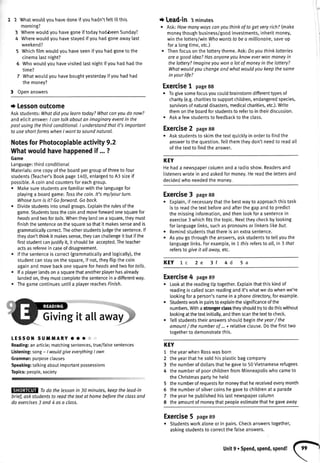
![7
I
KEY
1 False.Therehavebeenseveratexamplesovertheyears...
2 False.HisparentshadcomdfromLatviaandRussia.
3 False.Hemadea fortuneinthefurtradeandauction
4
5
6
business.
True
True
False.Hestartedanewspapercolumn...andlateraradio
SNOW.
True
False.Hesaid'lfI'dhadtwiceasmuch,I stillwouldhave
givenitallaway.
Exercise6 pase89
. ReadthroughtheinstructionsandtheLearnthis!box
together.Elicitanswersfromtheclass.Hightightthefact
thatsothatandinfinitivearemorecommonthanin orderto,
especiallyin aninformalstyle.
KEY inorder so
Exercise7 page89
. Focusontheinstructions.Studentscandotheexercise
aloneor in oairs.Checkanswers.
. Givestudents2 minutesto inventtheiranswers.They
dothisindividually.DividestudentsintoAsandBs.Tetl
themtheyaregoingto intervieweachother.Student
A isthelotterywinnerandStudentB ls a newspaper
reporter.
r Studentsroleplaythe interviews.Aftera fewminutes
theyreverseroles,StudentB is the lotterywinnerand
StudentA the newspaperreporter.
o lf thereistime,askoneortwopairsto actouttheir
interviewsto the class.
t Lessonoutcome
Askstudents:Whathaveyouleornedtodoy?Whatcanyoudo
now?andelicitanswers:lcan understandanarticleobouta
millionoire.I canunderstandthesongEverythingI own.Ask:
Whichusefulwordsor phraseshaveyou leorned?
1,1r';,1:ir::,6-]:,:;ir:,;r,:ii;
Arguingyourcasre,
tEssoll sutilARY o o.::':
FunctionalEnglish:doubtingandgivingalternativesuggestions,
concedingand refusingto concedean argument
Listening:dialogues;listeningforgistand specificwords
Speaking:role-play;negotiating
Topic:travel
Todo thelessonin 30 minutes,keepthelead-in
brief,do exercise2 asa classand limit thepreparationtimein
exercise7 andnumberof performancesin exercise8.
t Lead-in 3 minutes
. Ask:Whenyoungpeoplego ona backpockingholiday,what
kindof accommodotiondo theystoyin?(youthhostel,cheap
hotel,tent).
o Havea classdiscussionabouttheadvantagesand
disadvantagesoftheseformsof accommodation.
Exercise1 pageeo Cl z.tz
o Focusonthe photo.Ask:Whataretheycarrying?Whatare
theydoing?Wheredoyouthinktheyare?
. Referstudentsto theinstructionsandquestions.Eticitthe
meaningofgetsherownwoy.Playtherecordingandcheck
anSwer5.
o Witha strongerclasswritethequestionsontheboard.
Studentsdotheexerciseasa listeningexercisewithbooks
closed.
KEY
1 Theydisagreeaboutwhereto stay.
2 Sophiegetsherownway.
Exercise2 page9o
r Studentsdotheexerciseindividually.Checkanswers.
o Drawattentionto thewordcampsite,explainingthat
campingis a falsefriendin manylanguages.Campingcan
beusedto talkabouttheactivity,butnottheplace.
KEY
1 ordertod
2 sothatb
3 to / in orderto c
4 sothate
5 sothata
Exercise8 page8e f) z.rr
. Studentslistento thesongandreadthelyricsat thesame
time.Askthemto workwitha partnerto findthephrases
withthegivenmeanings.Pointoutthatthephrasesarein
thesameorderasthesong.
KEY
1 Youshelteredmefromharm
2 ThefinestyearsI everknew
3 I'dgiveup mylife
4 Thepartof methatcan'tletgo
5 takingthemallforgranted
CUTTURETIOTE- EYERWHIilAI OWII
EverythingI Awnis a popularsongwrittenbyBread,a
1970srockandro[[bandfromCalifomia-lt hasbeen
coveredbyBoyGeoge,'N SyncandRodStewart.
Exercise9 page89
o Studentsdiscussthequestionin pairsorsmallgroups.
Exercise10 page89
. Givestudentstimeto thinkaboutwhichthreeobiectsare
mostpreciousto themandwhy.Theycompareanswersin
pairsorsmallgroups.
ADDITIO]IAL SPEAKIfl G ACTIYITY
. Tellstudentsthat theyaregoingto imaginethat they
havewona largesumof moneyin the lottery.Writethe
questionsbelowonthe board:Where/whendid you
buythe ticket? Hawdid you chooseyournumbers?
Howmuchdid youwin? Howdid youfeel whenyou
found outT Whotareyougoing to do with the money?
Youaregoing to givesometo charity-Whichcharity?
KEY
1 Lydia
2 Sophie
3 Sophie
4 Lydia
5 Sophie
5 Sophie
Unit9 . Spend,spend,spend!](https://image.slidesharecdn.com/solutionsintermediateteachersbook-150104211909-conversion-gate02/85/Solutions-intermediate-teachers_book-100-320.jpg)
![Exercise3 pageeo f) z.rr
. Tellstudentstheyaregoingto listento therecordingtwice.
Thefirsttimetheyonlyhaveto matchthespeakerswiththe
disagreements.
KEY 1b 3a
TRAilSCRIPT2.33
1
Lity Weshouldgo shopping,Cameron.Ourparty'stomorrow,
andwe needto getsomefood.
CameronWhatshoutdwe get?
Lity Let'sdo roastchicken- everybodylikesroastchicken.
Andwe cangetsomesaladand potatoestoo ...
CameronDoyou realtythinkso?
Lity Yes.Whynot?
Cameronlt seemslikea totof workfor us - cookingchicken,
preparingsalad...
Lity Wecando it atlin the morning.Thatwaywe won't have
to do anythingat the lastminute.
CameronButLity,can'twe justbuysomecrispsand somepizzas?
Peoplewouldbe happywiththat.And it wouldbe much
easierfor us - and cheaper!Wecan'taffordto provide
roastchickenfor 25 peopte!
I supposeyoucouldbe right.
Sowe'lljustgetcrispsand pizzas,then.
oK.
Chloe.Couldyoucomeinto my officefor a moment.I
wantto discussthe newvendingmachinewithyou.
Whatnewvendingmachineisthis,James?
I wantto havea softdrinksvendingmachineput in the
schoolhallsothatthe studentscanbuydrinksat break-
time.
I don'tthinkthat'sa verygoodidea.Thekindof fizzy
drinksyougetfromvendingmachinesaren'tvery
heatthy.
I takeyourpoint,but on the otherhandthe studentsgo
and buyfizzydrinksfromshopsat lunchtimeanyway.
Howmuchwillit cost?
That'sjust it. lt won'tcostanything!Thesoftdrink
companywitlprovideit for free.
Exercise4 pageeo f) z.r
. Playthe recordingagain,pausingaftereachconversationfor
studentsto writetheiranswers.Checkanswers.
KEY lCameron 2Chtoe 3 Leo
Exercise5 page9o
. Focusontheexpressionsandthecategoryheadings.DeaI
withanyvocabularyissues.ltemswhichmaybeunfamiliar
areI tokeyourpoint andconcede(givein).
o Studentsworkaloneorwitha partnerto categorisethe
exDreSsrons.
. DuringfeedbackpointoutthatI supposeshowsreluctance.
5o,I supposeyoucouldberightis muchmorereluctant
thanYes,you'reright.
KEY A 4.8 B 3,5 c 7,6 D 2,7
Exercise6 page9o
. Studentsworkaloneorin pairsto addexpressionsfrom
exercise1 to thegroups.Checkanswershighlightingthe
followingpoints:Afterl'd ratherweusepaste.g.I'drather
wefound.Afterwe'dbebetteroffwe useverb+ -inge.g.
we'dbe betteroffleaving.
. Quicktypractisebothstructureswitha substitutiondritt.
KEY
A Realty?I'mnotsurethat'sa goodidea.
B Personally,I'dratherwefound...,True,but...,I reatlythink
we'dbebetteroffstaying....
C Well,ifthat'swhatyoureallywanttodo,thenOK.
D I'mnotconvinced.
CULTURE]IOTE . BRITISH POLITEI{ESS
Youmightwaritto pointoutthatBritishpeopletendto be
lessdirectthanmanyothelnationalities.Whenarguing
theytendto say:Doyoureallythinkso?Areyousureabout
thot?l'm notsurei* a goodidearatherthanI don'tagree
unlesstheyarespeakingto somebodytheyknowwell(asin
conversation3 ontherecording).Studentsmightfindthis
strangebutit'simportantforthemto beawareof it asthey
couldeasilycomeacrossasimpoliteif theyaretoodirect.
Exercise7 page9o
. Readthroughtheinstructionstogether.Givestudentstwoor
threeminutesto choosea topicandnotedownsuggestions
andalternativesuggestions.
Exercise8 page9o
. Studentsworkin pairsto prepareandrehearsetheir
dialogues.Allow5 minutesforthis.Remindthemto usethe
languagefromthe previousexercises.
o Ina strongerclassstudentsneedn'twritethefullsentences,
iustnotesasprompts.
Exercise9 page9o
. ChooseseveraIpairsto actouttheirconversations.lfyou
havea [argeclassorareshortoftime,dividetheclassinto2
groups.Studentsactouttheirdiatogueinfrontofthegroup.
t Lessonoutcome
Askstudents:Whatdid youlearntoday?Whatcanyoudo
now?andelicitanswers:I canexpressdoubts,givealternative
suggestions,concedeandrefuseto concedein an argument.
Ask:Whichusefulwordsandphraseshaveyoulearned?
2c
Lily
Cameron
Lily
z
James
Chtoe
James
Chtoe
lames
Chtoe
JameS
Chtoe Yes,but they'tlmakea lot of moneyout of it andgetfree
advertising- in ourschool.
lames I seewhatyoumean,butwe'I alsomakemoneyoutof
it. We'llget10p for everydrinkthat is sold.Thatcouldbe
f10,000 a year.
Chtoe I stillthinkI'm right.Advertisinghasno placein schools.
Youshouldturndowntheiroffer.
3
Leo lt's Dad'sbirthdayon Saturday,Mittie.Youhadn't
forgotten,hadyou?
Mittie No,l'vebeenthinkingaboutwhatto gethim.
Leo Anygoodideas?
Mitlie Let'sgethim a newcoat.He'sbeenwearingthatold grey
coatforyears- it's fattingapart.He'dlovea newone.
Leo Areyou sureaboutthat?Heprobablywearsthatcoatalt
thetime becausehe tikesit.
Mittie Hmm,maybe.Well,whydon'twe gethim a shirt,then?
Hehasn'tgot manyniceshirts,hashe?Thatredone he
wearsis horrible.
Leo Oh,I don'tagree.I quitelikeit. Andanyway,I'm notsure
ctothesarea goodpresentfor Dad.Helikesto choose
hisownclothes.
Miltie Wetl,whatwouldyousuggest?
Leo I don'tknow.A book,maybe.Howabouta bookabout
cricket?Helovescricket.
Mittie lt isn'ta veryexcitingpresent,though,is it.
Leo Maybenot,but he lovesbooks.
Miltie OK,whateveryouwant.I don'tfeelstronglyaboutit.
Unitg.Spend,spend,spend!
(F](https://image.slidesharecdn.com/solutionsintermediateteachersbook-150104211909-conversion-gate02/85/Solutions-intermediate-teachers_book-101-320.jpg)




